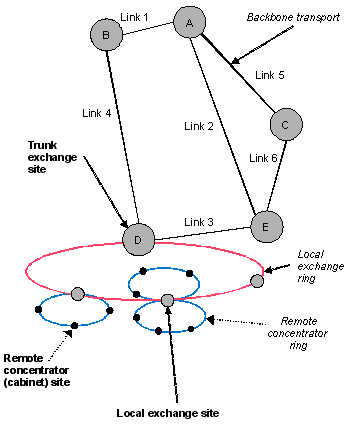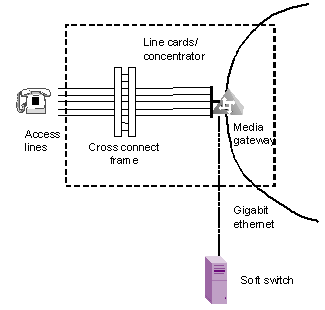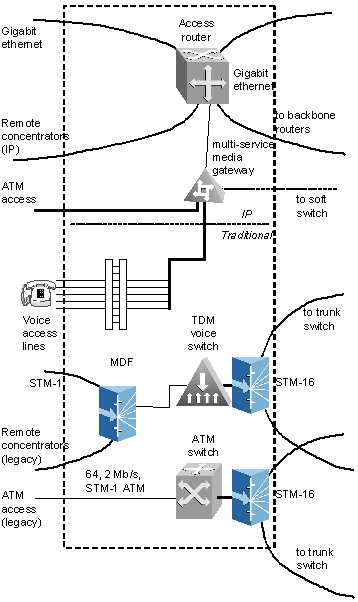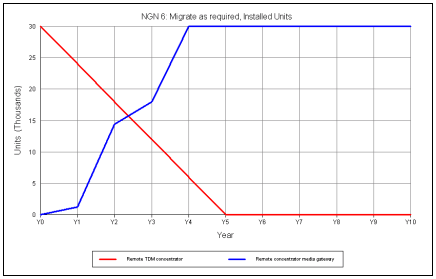The majority of incumbent operators worldwide carry voice traffic on traditional
circuit-switched networks. Data services such as ATM or frame relay are typically
handled by separate network architectures where each service is switched separately.
Meanwhile VoIP is rapidly emerging as a service in its own right, with
many users enjoying cheap and reasonable quality long-distance calls over best-efforts
Internet. VoIP is also the inevitable future transport for voice in the core network.
Operators believe they can achieve major capital and operational cost savings by
migrating their existing voice and data services to a common next generation network
(NGN) platform, where individual service interfaces are delivered at the edge of
the network through so-called multi-service access gateways.
The best strategy will vary according to the design and age of the existing network.
Our latest reference model explores the cost implications of different scenarios
for this transition and offers a scaleable methodology for modelling these diverse
network architectures.
Please register to download
a copy of this reference model
Network topology

The network consists of five trunk exchanges (A to E) which are connected via an
SDH backbone with six links. A set of local exchanges is connected to each trunk
exchange via local exchange rings. Voice customers are connected to the local exchanges
via remote concentrators and remote concentrator rings, while data customers are
connected directly at the local exchange. The five trunk exchanges in the network
are modelled individually. The local exchanges and other equipment linked to these
trunk exchanges are averaged over those trunk exchanges.
Services and demand
Only a small selection of types of services are included in the reference model:
voice, 64kbit/s ATM and 2048kbit/s ATM. For each of the possible routes between
the trunk exchanges, a set of services is defined, and can be costed separately.
A route is defined simply in terms of its two endpoints, for example node A to node
C. The intermediate path taken is captured in a core traffic matrix. For the five
trunk exchanges shown, there are 15 possible routes, and therefore 15 sets of services.
For the voice and ATM services, demand is specified for each of the 15 routes, without
being specific about individual local exchange sites. So, for example, traffic for
route A–E is from any local exchange on trunk switch A to any local exchange on
trunk switch E, whereas traffic for route A–A is from any local exchange on trunk
switch A to any local exchange on the same trunk switch.
The traffic generated by the 15 services (routes) is mapped onto the trunk exchanges
using an access matrix and a core matrix. These matrices are used to calculate the
traffic on each trunk exchange interface by multiplying the traffic carried for
each service by route by the multiplier for the exchange and summing over all services.
The five exchanges are modelled separately, based on a common template definition.
Migration scenarios
There are two steps to the migration from the traditional network to NGN. The first
step is to add the IP network equipment and run it alongside the traditional infrastructure
while customers are being migrated. The second step, once all customers are migrated,
is to remove the legacy network equipment.
A media gateway is installed at a remote concentrator site. This gateway converts
TDM circuits to IP and multiplexes them onto a gigabit Ethernet network (see Figure
below). The GigE network is connected to the access router at the local exchange. The
media gateway equipment includes new line cards (which are voice/DSL-capable) and
the GigE interface. A soft switch (or gateway controller) is deployed at each trunk
exchange site, which establishes call sessions and identifies the destination IP
addresses of the call recipients for media packets.

Remote concentrator – NGN
An IP access router is deployed at each local exchange site. The remote concentrators
are connected to this access router via a GigE ring. Each router is connected to
other access routers on a local exchange ring and to the backbone routers via further
GigE rings. ATM access circuits are migrated from the traditional ATM switch to
the access router via a multi-service media gateway.

Local exchange during migration
Three scenarios are modelled: a proactive migration, where equipment in the traditional
networks is removed before the end of its life and replaced with IP equipment; a
migrate-as-required migration, where equipment is replaced only when it reaches
the end of its life; and no migration, which is used as a base case to examine the
effects of not migrating to IP at all.

Remote TDM concentrators gradually replaced by IP media gateways in as-required
scenario
The purpose of the migration is primarily to reduce capital and ongoing costs, and
therefore the key model results are the different operating costs, capex and depreciation
for the various networks and scenarios considered.